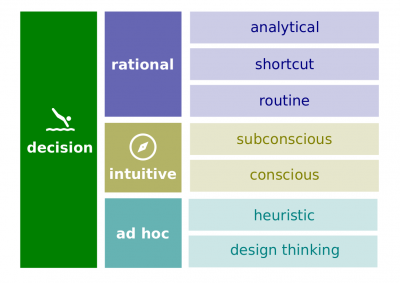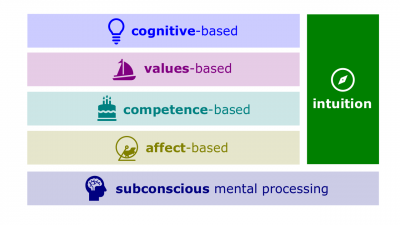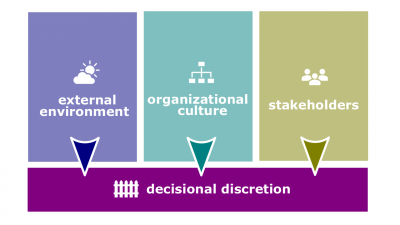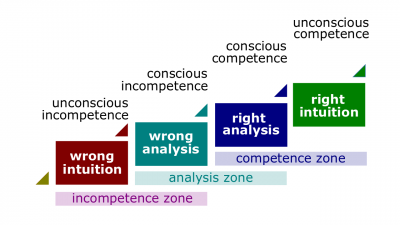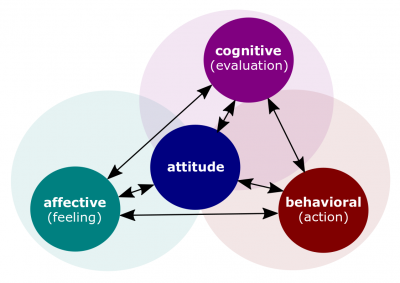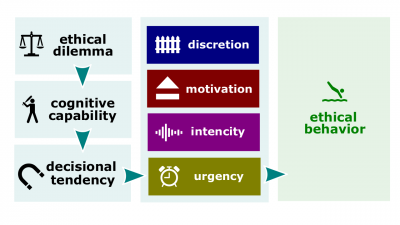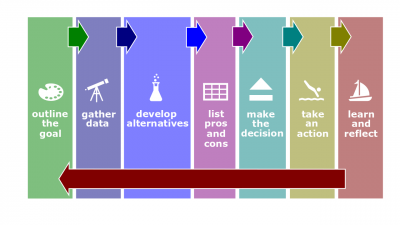Difference between revisions of "Individual Decisions Quarter"
(→Instruments) |
|||
| (45 intermediate revisions by 2 users not shown) | |||
| Line 1: | Line 1: | ||
[[Individual Decisions Quarter]] (hereinafter, the ''Quarter'') is a lecture introducing the learners to [[individuals design]]s primarily through key topics related to [[individual decision-making]]. The ''Quarter'' is the third of four lectures of [[Individuals Quadrivium]], which is the fourth of seven modules of '''[[Septem Artes Administrativi]]''' (hereinafter, the ''Course''). The ''Course'' is designed to introduce the learners to general concepts in [[business administration]], [[management]], and [[organizational behavior]]. | [[Individual Decisions Quarter]] (hereinafter, the ''Quarter'') is a lecture introducing the learners to [[individuals design]]s primarily through key topics related to [[individual decision-making]]. The ''Quarter'' is the third of four lectures of [[Individuals Quadrivium]], which is the fourth of seven modules of '''[[Septem Artes Administrativi]]''' (hereinafter, the ''Course''). The ''Course'' is designed to introduce the learners to general concepts in [[business administration]], [[management]], and [[organizational behavior]]. | ||
| − | |||
==Outline== | ==Outline== | ||
| − | ''[[Human Motivations Quarter]] is the predecessor lecture. In the [[enterprise | + | ''[[Human Motivations Quarter]] is the predecessor lecture. In the [[enterprise envisioning]] series, the previous lecture is [[Effort Engineering Quarter]].'' |
===Concepts=== | ===Concepts=== | ||
#'''[[Decision]]'''. A choice made from among two or more alternatives. | #'''[[Decision]]'''. A choice made from among two or more alternatives. | ||
| − | #*[[Programmed decision]]. | + | #*[[Programmed decision]]. Any [[decision]] to follow a [[policy]], [[operative rule]], another [[regulation]], or to routinely repeat one's previous decision that has been made while handling a similarly [[structured task]]. |
| − | #*[[Non-programmed decision]]. A unique and nonrecurring [[decision]] that requires a custom-made solution. | + | #*[[Non-programmed decision]] ([[Non-programmed decision|creative decision]]). A unique and nonrecurring [[decision]] that requires a custom-made [[solution]]. |
| − | #'''[[ | + | #'''[[Decision-making]]'''. The action or process of making [[non-programmed decision]]s; [[creative behavior]] resulted in a new [[decision]]. |
| − | + | #*[[Individual decision-making]]. [[Decision-making]] made by an individual as opposed to [[group decision-making]]. | |
| − | + | #*[[File:Decision.png|400px|thumb|right|[[Decision-making approach]]]][[Decision-making approach]]. A particular manner of taking preliminary steps toward making a [[decision]]. | |
| − | #*[[Individual decision-making]]. [[Decision making]] made by an individual as opposed to [[group decision-making]]. | + | #'''[[Intuitive decision-making]]'''. Unconscious [[decision-making]] on the basis of distilled experience, feelings, and accumulated judgment. |
| − | #'''[[ | ||
#*[[File:Intuition.png|400px|thumb|right|[[Intuition]]]][[Intuition]]. An instinctive feeling not necessarily supported by research. | #*[[File:Intuition.png|400px|thumb|right|[[Intuition]]]][[Intuition]]. An instinctive feeling not necessarily supported by research. | ||
| − | # | + | #'''[[Rational decision-making]]'''. [[Decision-making]] that produces choices that are logical and consistent and maximize value. |
#*[[Rationale]]. A reasoning characterized by making consistent, value-maximizing choices within specified constraints. | #*[[Rationale]]. A reasoning characterized by making consistent, value-maximizing choices within specified constraints. | ||
| − | |||
#'''[[Decision criteria]]'''. Criteria that define what's important or relevant to resolving a problem. | #'''[[Decision criteria]]'''. Criteria that define what's important or relevant to resolving a problem. | ||
| − | #*[[Quantitative approach in management]]. The use of quantitative techniques to improve [[decision making]]. | + | #*[[Quantitative approach in management]]. The use of quantitative techniques to improve [[decision-making]]. |
#*[[File:Discretion.png|400px|thumb|right|[[Decisional discretion]]]][[Decisional discretion]]. The freedom to decide what should be done in a particular situation. | #*[[File:Discretion.png|400px|thumb|right|[[Decisional discretion]]]][[Decisional discretion]]. The freedom to decide what should be done in a particular situation. | ||
| − | # | + | #[[File:Competence-levels.png|400px|thumb|right|[[Structured-task competence]]]]'''[[Structured-task competence]]'''. A [[model]] that describes psychological states involved in the process of progressing from incompetence to analytical competence and, further, to intuitive competence in some knowledge, skill, and/or ability. |
| − | #*[[Unconscious incompetence]] (or [[wrong intuition]]). A situation in which the individual neither understands nor knows how to accomplish a [[task]] and does not necessarily recognize the deficit. | + | #*[[Unconscious incompetence]] (or [[wrong intuition]]). A situation in which the individual neither understands nor knows how to accomplish a [[job task]] and does not necessarily recognize the deficit. |
| − | #*[[Conscious incompetence]] (or [[wrong analysis]]). A situation in which the individual neither understands or knows how to accomplish a [[task]], but he or she recognizes the deficit. He or she also realizes the value of new knowledge, skill, and/or ability needed in addressing the deficit. The making of mistakes can be integral to the learning process at this level of competence. | + | #*[[Conscious incompetence]] (or [[wrong analysis]]). A situation in which the individual neither understands or knows how to accomplish a [[job task]], but he or she recognizes the deficit. He or she also realizes the value of new knowledge, skill, and/or ability needed in addressing the deficit. The making of mistakes can be integral to the learning process at this level of competence. |
| − | #*[[Conscious competence]] (or [[right analysis]]). A situation in which the individual understands and/or knows how to accomplish a [[task]]. However, demonstrating the knowledge, skill, and/or ability requires concentration. It may be broken down into steps, and there is heavy conscious involvement in executing the needed knowledge, skill, and/or ability. | + | #*[[Conscious competence]] (or [[right analysis]]). A situation in which the individual understands and/or knows how to accomplish a [[job task]]. However, demonstrating the knowledge, skill, and/or ability requires concentration. It may be broken down into steps, and there is heavy conscious involvement in executing the needed knowledge, skill, and/or ability. |
| − | #*[[Unconscious competence]] (or [[right intuition]]). A situation in which the individual not only understands and knows how to accomplish a [[task]], but has had so much practice with a skill that it has become "second nature" and can be performed easily. As a result, the skill can sometimes be performed while executing another [[task]]. The individual may be able to teach it to others, depending upon how and when it was learned. | + | #*[[Unconscious competence]] (or [[right intuition]]). A situation in which the individual not only understands and knows how to accomplish a [[job task]], but has had so much practice with a skill that it has become "second nature" and can be performed easily. As a result, the skill can sometimes be performed while executing another [[job task]]. The individual may be able to teach it to others, depending upon how and when it was learned. |
| − | #'''[[Behavior]]'''. The | + | #'''[[Behavior]]'''. The way in which someone, something, or their group functions, operates, and/or conducts oneself. |
#*[[Intention]]. A decision to act in a given way. | #*[[Intention]]. A decision to act in a given way. | ||
#*[[Behaviorism]]. A theory that argues that behavior follows stimuli in a relatively unthinking manner. | #*[[Behaviorism]]. A theory that argues that behavior follows stimuli in a relatively unthinking manner. | ||
| − | #'''[[Attitude]]'''. An evaluative statement or judgment, either favorable or unfavorable, concerning objects, people, or events. | + | #*[[Creative behavior]]. The way in which someone, something, or their group makes [[non-programmed decision]]s and acts on them. |
| − | #*[[Cognitive | + | #[[File:Attitude.png|400px|thumb|right|[[Attitude]]]]'''[[Attitude]]'''. An evaluative statement or judgment, either favorable or unfavorable, concerning objects, people, or events. |
| − | #*[[Affective | + | #*[[Cognitive attitude]]. That part of an [[attitude]] that's made up of the beliefs, opinions, knowledge, or information held by a person. In other words, the ''cognitive component'' is the opinion or belief segment of an [[attitude]]. |
| − | #*[[Behavioral | + | #*[[Affective attitude]]. The emotional or feeling segment of an [[attitude]]. |
| − | #'''[[ | + | #*[[Behavioral attitude]]. The segment of an [[attitude]] that refers to an intention to behave in a certain way toward someone or something. |
| − | #*[[Certainty]]. A situation in which a decision maker can make accurate | + | #'''[[Situational control]]'''. The [[capacity]] of a [[decision maker]] to manage the situation and estimate the likelihood of certain outcomes. |
| + | #*[[Certainty]]. A situation in which a decision maker can make accurate [[decision]]s because all the data and outcomes are known. | ||
#*[[Uncertainty]]. A situation in which a decision maker has neither [[certainty]] nor reasonable probability estimates available. | #*[[Uncertainty]]. A situation in which a decision maker has neither [[certainty]] nor reasonable probability estimates available. | ||
#'''[[Ad hoc decision-making]]'''. | #'''[[Ad hoc decision-making]]'''. | ||
#*[[Design thinking]]. Approaching management problems as designers approach design problems. | #*[[Design thinking]]. Approaching management problems as designers approach design problems. | ||
| − | #*[[Heuristic]]. A rule of thumb that decision makers use to simplify [[decision making]]. | + | #*[[Heuristic]]. A rule of thumb that decision makers use to simplify [[decision-making]]. |
#'''[[Core self-evaluation]]'''. Bottom-line conclusions individuals have about their capacities, competence, and worth as a person. In other words, self-believing in one's inner worth and basic competence. | #'''[[Core self-evaluation]]'''. Bottom-line conclusions individuals have about their capacities, competence, and worth as a person. In other words, self-believing in one's inner worth and basic competence. | ||
#*[[General mental ability]]. An overall factor of intelligence, as suggested by the positive correlations among specific intellectual ability dimensions. | #*[[General mental ability]]. An overall factor of intelligence, as suggested by the positive correlations among specific intellectual ability dimensions. | ||
#'''[[Decisional tendency]]'''. | #'''[[Decisional tendency]]'''. | ||
| − | #*[[Bounded rationality]]. [[Decision making]] that is rational, but limited (bounded) by an individual's ability to process information. In other words, [[bounded rationality]] is a process of making decisions by constructing simplified models that extract the essential features from problems without capturing all their complexity. | + | #*[[Bounded rationality]]. [[Decision-making]] that is rational, but limited (bounded) by an individual's ability to process information. In other words, [[bounded rationality]] is a process of making decisions by constructing simplified models that extract the essential features from problems without capturing all their complexity. |
#*[[Escalation of commitment]]. An increased commitment to a previous decision despite evidence it may have been wrong. | #*[[Escalation of commitment]]. An increased commitment to a previous decision despite evidence it may have been wrong. | ||
#*[[Risk aversion]]. The tendency to prefer a sure gain of a moderate amount over a riskier outcome, even if the riskier outcome might have a higher expected payoff. | #*[[Risk aversion]]. The tendency to prefer a sure gain of a moderate amount over a riskier outcome, even if the riskier outcome might have a higher expected payoff. | ||
| − | #'''[[Decision-making dilemma]]'''. Optimizing vs. satisficing, intuitive vs rational, Agile vs rigid, conservative vs aggressive | + | #'''[[Decision-making dilemma]]'''. Optimizing vs. satisficing, intuitive vs rational vs ad hoc, Agile vs rigid, conservative vs aggressive, linear vs nonlinear |
#*[[Satisfice]]. Acceptance of solutions that are "good enough." | #*[[Satisfice]]. Acceptance of solutions that are "good enough." | ||
#*[[Allostasis]]. Working to change behavior and attitude to find stability. | #*[[Allostasis]]. Working to change behavior and attitude to find stability. | ||
| − | |||
#'''[[Self-regulation strategy]]'''. | #'''[[Self-regulation strategy]]'''. | ||
#*[[Prevention focus]]. A self-regulation strategy that involves striving for goals by fulfilling duties and obligations. | #*[[Prevention focus]]. A self-regulation strategy that involves striving for goals by fulfilling duties and obligations. | ||
#*[[Promotion focus]]. A self-regulation strategy that involves striving for goals through advancement and accomplishment. | #*[[Promotion focus]]. A self-regulation strategy that involves striving for goals through advancement and accomplishment. | ||
#[[File:Ethical-dilemma.png|400px|thumb|right|[[Ethical dilemma]]]]'''[[Ethical dilemma]]'''. A situation in which individuals are required to define right and wrong conduct. | #[[File:Ethical-dilemma.png|400px|thumb|right|[[Ethical dilemma]]]]'''[[Ethical dilemma]]'''. A situation in which individuals are required to define right and wrong conduct. | ||
| − | #*[[Ethics]]. Principles, values, and beliefs that define what is right and wrong behavior. | + | #*[[Ethics]]. Principles, [[values]], and beliefs that define what is right and wrong behavior. |
#*[[Behavioral ethics]]. Analyzing how people actually behave when confronted with [[ethical dilemma]]s. | #*[[Behavioral ethics]]. Analyzing how people actually behave when confronted with [[ethical dilemma]]s. | ||
#'''[[Cognitive dissonance]]'''. Any incompatibility or inconsistency between two or more [[attitude]]s or between behavior and attitudes. | #'''[[Cognitive dissonance]]'''. Any incompatibility or inconsistency between two or more [[attitude]]s or between behavior and attitudes. | ||
===Roles=== | ===Roles=== | ||
| − | #'''[[Operations research analyst]]'''. A professional who formulates and applies mathematical modeling and other optimizing methods to develop and interpret information that assists management with decision making, policy formulation, or other managerial functions. He or she may collect and analyze data and develop decision support software, service, or products, as well as develop and supply optimal time, cost, or logistics networks for program evaluation, review, or implementation. | + | #'''[[Decision maker]]'''. |
| + | #'''[[Operations research analyst]]'''. A professional who formulates and applies mathematical modeling and other optimizing methods to develop and interpret information that assists management with [[decision-making]], policy formulation, or other managerial functions. He or she may collect and analyze data and develop decision support software, service, or products, as well as develop and supply optimal time, cost, or logistics networks for program evaluation, review, or implementation. | ||
===Methods=== | ===Methods=== | ||
| Line 66: | Line 64: | ||
===Instruments=== | ===Instruments=== | ||
| − | #'''[[Rational decision-making model]]'''. A decision-making model that describes how individuals may rationally behave in order to maximize the outcomes from the [[decision]].<blockquote><table class="wikitable" width=100% style="text-align:center;"><tr><th>[[ | + | #'''[[Rational decision-making model]]'''. A decision-making model that describes how individuals may rationally behave in order to maximize the outcomes from the [[decision]].<blockquote><table class="wikitable" width=100% style="text-align:center;"><tr><th>[[DREPD]]</th><th>[[GOFER]]</th><th>[[DECIDE]]</th><th>[[Seven-step decision-making]]</th></tr><tr><td rowspan="4">[[Enterprise discovery|'''D'''iscover]]</td><td rowspan="2">'''G'''oals clarification.</td><td>'''D'''efine the problem.</td><td>'''O'''utline your goal and outcome.</td></tr><tr><td>'''E'''stablish all the criteria (constraints).</td><td>Gather data.</td></tr><tr><td>'''Options''' generation.</td><td rowspan="3">'''C'''onsider all the alternatives.</td><td rowspan="2">Develop alternatives.</td></tr><tr><td>'''F'''acts-finding.</td></tr><tr><td>[[Enterprise research|'''R'''esearch]]</td><td>Consideration of '''E'''ffects</td><td>List pros and cons of each alternative.</td></tr><tr><td>[[Enterprise envisioning|'''E'''nvision]]</td><td rowspan="3">'''R'''eview and implementation.</td><td>'''I'''dentify the best alternative.</td><td>Make the decision.</td></tr><tr><td>[[Enterprise planning|'''P'''lan]]</td><td>'''D'''evelop and implement a plan of action</td><td>Immediately take action to implement it.</td></tr><tr><td>[[Enterprise discovery|'''D'''iscover]] (in a new cycle)</td><td>'''E'''valuate and monitor the solution and examine feedback when necessary</td><td>Learn from and reflect on the decision.</td></tr></table></blockquote> |
#*[[File:7-step-rational.png|400px|thumb|right|[[Seven-step decision-making]]]][[Seven-step decision-making]]. A [[rational decision-making model]] that consists of seven steps. | #*[[File:7-step-rational.png|400px|thumb|right|[[Seven-step decision-making]]]][[Seven-step decision-making]]. A [[rational decision-making model]] that consists of seven steps. | ||
===Practices=== | ===Practices=== | ||
| − | ''[[ | + | ''[[Talent Management Quarter]] is the successor lecture. In the [[enterprise envisioning]] series, the next lecture is [[User Experience Quarter]].'' |
==Materials== | ==Materials== | ||
| Line 81: | Line 79: | ||
==See also== | ==See also== | ||
| + | |||
| + | [[Category:Septem Artes Administrativi]][[Category:Lecture notes]] | ||
Latest revision as of 18:59, 12 May 2023
Individual Decisions Quarter (hereinafter, the Quarter) is a lecture introducing the learners to individuals designs primarily through key topics related to individual decision-making. The Quarter is the third of four lectures of Individuals Quadrivium, which is the fourth of seven modules of Septem Artes Administrativi (hereinafter, the Course). The Course is designed to introduce the learners to general concepts in business administration, management, and organizational behavior.
Contents
Outline
Human Motivations Quarter is the predecessor lecture. In the enterprise envisioning series, the previous lecture is Effort Engineering Quarter.
Concepts
- Decision. A choice made from among two or more alternatives.
- Programmed decision. Any decision to follow a policy, operative rule, another regulation, or to routinely repeat one's previous decision that has been made while handling a similarly structured task.
- Non-programmed decision (creative decision). A unique and nonrecurring decision that requires a custom-made solution.
- Decision-making. The action or process of making non-programmed decisions; creative behavior resulted in a new decision.
- Individual decision-making. Decision-making made by an individual as opposed to group decision-making.
- Decision-making approach. A particular manner of taking preliminary steps toward making a decision.
- Intuitive decision-making. Unconscious decision-making on the basis of distilled experience, feelings, and accumulated judgment.
- Intuition. An instinctive feeling not necessarily supported by research.
- Rational decision-making. Decision-making that produces choices that are logical and consistent and maximize value.
- Rationale. A reasoning characterized by making consistent, value-maximizing choices within specified constraints.
- Decision criteria. Criteria that define what's important or relevant to resolving a problem.
- Quantitative approach in management. The use of quantitative techniques to improve decision-making.
- Decisional discretion. The freedom to decide what should be done in a particular situation.
- Structured-task competence. A model that describes psychological states involved in the process of progressing from incompetence to analytical competence and, further, to intuitive competence in some knowledge, skill, and/or ability.
- Unconscious incompetence (or wrong intuition). A situation in which the individual neither understands nor knows how to accomplish a job task and does not necessarily recognize the deficit.
- Conscious incompetence (or wrong analysis). A situation in which the individual neither understands or knows how to accomplish a job task, but he or she recognizes the deficit. He or she also realizes the value of new knowledge, skill, and/or ability needed in addressing the deficit. The making of mistakes can be integral to the learning process at this level of competence.
- Conscious competence (or right analysis). A situation in which the individual understands and/or knows how to accomplish a job task. However, demonstrating the knowledge, skill, and/or ability requires concentration. It may be broken down into steps, and there is heavy conscious involvement in executing the needed knowledge, skill, and/or ability.
- Unconscious competence (or right intuition). A situation in which the individual not only understands and knows how to accomplish a job task, but has had so much practice with a skill that it has become "second nature" and can be performed easily. As a result, the skill can sometimes be performed while executing another job task. The individual may be able to teach it to others, depending upon how and when it was learned.
- Behavior. The way in which someone, something, or their group functions, operates, and/or conducts oneself.
- Intention. A decision to act in a given way.
- Behaviorism. A theory that argues that behavior follows stimuli in a relatively unthinking manner.
- Creative behavior. The way in which someone, something, or their group makes non-programmed decisions and acts on them.
- Attitude. An evaluative statement or judgment, either favorable or unfavorable, concerning objects, people, or events.
- Cognitive attitude. That part of an attitude that's made up of the beliefs, opinions, knowledge, or information held by a person. In other words, the cognitive component is the opinion or belief segment of an attitude.
- Affective attitude. The emotional or feeling segment of an attitude.
- Behavioral attitude. The segment of an attitude that refers to an intention to behave in a certain way toward someone or something.
- Situational control. The capacity of a decision maker to manage the situation and estimate the likelihood of certain outcomes.
- Certainty. A situation in which a decision maker can make accurate decisions because all the data and outcomes are known.
- Uncertainty. A situation in which a decision maker has neither certainty nor reasonable probability estimates available.
- Ad hoc decision-making.
- Design thinking. Approaching management problems as designers approach design problems.
- Heuristic. A rule of thumb that decision makers use to simplify decision-making.
- Core self-evaluation. Bottom-line conclusions individuals have about their capacities, competence, and worth as a person. In other words, self-believing in one's inner worth and basic competence.
- General mental ability. An overall factor of intelligence, as suggested by the positive correlations among specific intellectual ability dimensions.
- Decisional tendency.
- Bounded rationality. Decision-making that is rational, but limited (bounded) by an individual's ability to process information. In other words, bounded rationality is a process of making decisions by constructing simplified models that extract the essential features from problems without capturing all their complexity.
- Escalation of commitment. An increased commitment to a previous decision despite evidence it may have been wrong.
- Risk aversion. The tendency to prefer a sure gain of a moderate amount over a riskier outcome, even if the riskier outcome might have a higher expected payoff.
- Decision-making dilemma. Optimizing vs. satisficing, intuitive vs rational vs ad hoc, Agile vs rigid, conservative vs aggressive, linear vs nonlinear
- Satisfice. Acceptance of solutions that are "good enough."
- Allostasis. Working to change behavior and attitude to find stability.
- Self-regulation strategy.
- Prevention focus. A self-regulation strategy that involves striving for goals by fulfilling duties and obligations.
- Promotion focus. A self-regulation strategy that involves striving for goals through advancement and accomplishment.
- Ethical dilemma. A situation in which individuals are required to define right and wrong conduct.
- Ethics. Principles, values, and beliefs that define what is right and wrong behavior.
- Behavioral ethics. Analyzing how people actually behave when confronted with ethical dilemmas.
- Cognitive dissonance. Any incompatibility or inconsistency between two or more attitudes or between behavior and attitudes.
Roles
- Decision maker.
- Operations research analyst. A professional who formulates and applies mathematical modeling and other optimizing methods to develop and interpret information that assists management with decision-making, policy formulation, or other managerial functions. He or she may collect and analyze data and develop decision support software, service, or products, as well as develop and supply optimal time, cost, or logistics networks for program evaluation, review, or implementation.
Methods
- Decision table. A decision-making technique that specifies complex business rules or logic concisely in an easy-to-read tabular format, specifying all of the possible conditions and actions that need to be accounted for in business rules.
- Decision tree. A decision-making technique that provides a graphical alternative to decision tables by illustrating conditions and actions in sequence. In other words, the decision tree is a diagram that describes a decision under consideration and the implications of choosing one or another of the available alternatives. It incorporates probabilities or risks and the costs or rewards of each logical path of events and future decisions.
Instruments
- Rational decision-making model. A decision-making model that describes how individuals may rationally behave in order to maximize the outcomes from the decision.
DREPD GOFER DECIDE Seven-step decision-making Discover Goals clarification. Define the problem. Outline your goal and outcome. Establish all the criteria (constraints). Gather data. Options generation. Consider all the alternatives. Develop alternatives. Facts-finding. Research Consideration of Effects List pros and cons of each alternative. Envision Review and implementation. Identify the best alternative. Make the decision. Plan Develop and implement a plan of action Immediately take action to implement it. Discover (in a new cycle) Evaluate and monitor the solution and examine feedback when necessary Learn from and reflect on the decision. - Seven-step decision-making. A rational decision-making model that consists of seven steps.
Practices
Talent Management Quarter is the successor lecture. In the enterprise envisioning series, the next lecture is User Experience Quarter.
